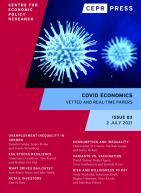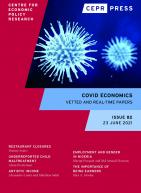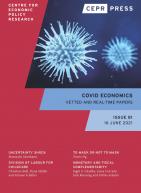
We analyze the impact of the COVID-19 pandemic and government policies on firms' aid take-up, layoff and furlough decisions using newly collected survey data for 10,642 small, medium and large Danish firms. This is the first representative sample of firms reporting the pandemic's impact on their revenue and labor choices, showing a steep decline in revenue and a strong reported effect of labor aid take-up on lower job separations. First, we document that relative to a normal year, a quarter more firms have experienced revenue declines exceeding 35 percent. Second, we characterize the firms that took up aid and the type of aid package they chose - labor-based aid, fixed cost support or fiscal-based tax delays. Third, we compare their actual layoff and furlough decisions with reported counterfactual decisions in the absence of aid.
Citation
Scur, D, B Larsen, I Schmutte and M Bennedsen (2020), ‘Preserving job matches during the COVID-19 pandemic: firm-level evidence on the role of government aid‘, COVID Economics 27, CEPR Press, Paris & London. https://cepr.org/publications/covid-economics-issue-27#392514_392903_390504
We study liquidity conditions in the corporate bond market since the onset of the COVID-19 pandemic. We find that in mid-March 2020, as selling pressure surged, dealers were wary of accumulating inventory on their balance sheets, perhaps out of concern for violating regulatory requirements. As a result, the cost to investors of trading immediately with a dealer surged. A portion of transactions migrated to a slower, less costly process wherein dealers arranged for trades directly between customers without using their own balance sheet space. Interventions by the Federal Reserve appear to have relaxed balance sheet constraints: soon after they were announced, dealers began absorbing inventory, bid-ask spreads declined, and market liquidity started to improve. Interestingly, liquidity conditions improved for bonds that were eligible for the Fed’s lending/purchase programs and for bonds that were ineligible. Hence, by allowing dealers to unload certain assets from their balance sheet, the Fed’s interventions may have helped dealers to better intermediate a wide variety of assets, including those not directly targeted.
Citation
Zúñiga, D, P Weill, S Liu, D Lindsay, B Lester and M Kargar (2020), ‘Corporate Bond Liquidity During the COVID-19 Crisis‘, COVID Economics 27, CEPR Press, Paris & London. https://cepr.org/publications/covid-economics-issue-27#392514_392903_390505
Latin American countries introduced rapid emergency measures to sustain the income of informal workers and their families during shelter-in-place orders to contain COVID-19. The effectiveness of these measures is limited. The coverage and replacement rates of usual labor income are high among the first quintile of the population but fairly low in the second and third quintiles, where a substantial fraction of households are informal and have limited ability to telework. If governments plan to extend lockdown measures or reintroduce them in the future, they might need to consider broader income transfers for the lower-middle class.
Citation
Messina, J and M Busso (2020), ‘The Challenge of Protecting Informal Households during the COVID-19 Pandemic: Evidence from Latin America‘, COVID Economics 27, CEPR Press, Paris & London. https://cepr.org/publications/covid-economics-issue-27#392514_392903_390506
We use the synthetic control method to analyze the effect of face masks on the spread of Covid-19 in Germany. Our identification approach exploits regional variation in the point in time when face masks became compulsory. Depending on the region we analyse, we find that face masks reduced the cumulative number of registered Covid-19 cases between 2.3% and 13% over a period of 10 days after they became compulsory. Assessing the credibility of the various estimates, we conclude that face masks reduce the daily growth rate of reported infections by around 40%.
Citation
Wälde, K, T Mitze, J Rode and R Kosfeld (2020), ‘Face Masks Considerably Reduce Covid-19 Cases in Germany - A synthetic control method approach‘, COVID Economics 27, CEPR Press, Paris & London. https://cepr.org/publications/covid-economics-issue-27#392514_392903_390507
How do optimal policies to control the spread of SARS-CoV-2 vary across countries? In an influential recent paper, Eichenbaum, Rebelo, and Trabandt (2020) incorporate economic behavior into a standard epidemiological model calibrated to the United States, finding that spontaneous social distancing will fall short of the social optimum without policy intervention. In this paper, we apply and extend their model to explore how optimal policy varies across contexts depending on demography, comorbidities, and health system strength -- which affect the infection fatality rate -- as well as poverty -- which affects agents' willingness to forego current consumption to reduce disease risk.  Calibrating the model to Uganda, we calculate an optimal path for a containment policy equivalent to a 4% consumption tax  over one year (compared to a 40% tax in the U.S.), which reduces predicted mortality by roughly 5.5% (compared to 28.2% in the U.S.). Notably, the normative predictions of the model constitute poor positive predictions. Actual containment policies in Uganda and many other developing countries with high poverty and favorable demographics have been relatively severe, and have been met with broad public approval despite high economic costs. Within the model, widespread overestimation of the risk of contracting and dying from the disease provides one possible explanation for this pattern.
Citation
von Carnap, T, J Sandefur, T Bold, S Ghisolfi and I Almås (2020), ‘The Macroeconomics of Pandemics in Developing Countries: an Application to Uganda‘, COVID Economics 27, CEPR Press, Paris & London. https://cepr.org/publications/covid-economics-issue-27#392514_392903_390508
Many countries are taking measures stopping productive activities to slow down the spread of COVID-19. At times these measures have been criticized as being excessive and too costly. In this paper we make an attempt to understand the optimal response to an infectious disease. We find that the observed policies are very close to a simple welfare maximization problem of a planner who tries to stop the diffusion of the disease. These extreme measures seem optimal in spite of the high output cost that it may have in the short run, and for various curvatures of the welfare function. The desire for cost smoothing makes more likely that either mitigation or no intervention strategies are optimal, but it does not greatly affect the optimal duration and intensity of the quarantines. We then study the possibility of either complementing or substituting the quarantine policy with random testing. We find that testing is a very close substitute of quarantine and can substantially reduce the need for indiscriminate quarantines.
Citation
Shi, L and F Piguillem (2020), ‘Optimal COVID-19 Quarantine and Testing Policies‘, COVID Economics 27, CEPR Press, Paris & London. https://cepr.org/publications/covid-economics-issue-27#392514_392903_391042


Covid Economics - Issue 82
- Restaurant Closures during the Pandemic: A Descriptive Analysis
- Underreporting Child Maltreatment during the Pandemic: Evidence from Colorado
- Covid-19 impact on Artistic Income
- COVID-19, Employment, and Gender: Evidence from Nigeria
- The Importance of Being Earners: Modelling the Implications of Changes to Welfare Contributions on Macroeconomic Recovery
